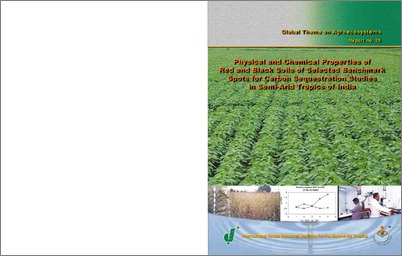Physical and Chemical Properties of Red and Black Soils of Selected Benchmark Spots for Carbon Sequestration Studies in Semi-Arid Tropics of India
Abstract
Physical (nine characteristics) and chemical (14) properties of red and black soils are described: sand, silt, clay, fine clay, BD, COLE, HC (hydraulic conductivity) and WDC; pH (H2O and KCl), EC, OC, CaCO3, clay CO3, extractable Ca, Mg, Na, K, CEC, clay CEC, BS and ESP are described in three ecosystems, namely sub-humid (moist and dry) (SH (m) and SH (d)), semi-arid (moist and dry) (SA (m) and SA (d)) and arid in SAT, India. Clay contents vary between 30% in arid system to 82% in sub-humid (dry) system and 79% in semi-arid (dry) system. The red soils contain 8–-55% clay. Fine clay ( permanent fallow (grassland), horticultural system > agricultural system > wasteland. Surface soils of agricultural and horticultural systems store higher SIC as compared to other systems. The surface soils of semi-arid (moist) show higher SOC under agricultural system due to inclusion of sun hemp for green manuring in crop rotation. The average SOC values follow the trend of SA (m) (0.825%) > SH (d) (0.804%) > SH (m) (0.642%) > SA (d) (0.633%) > arid (0.594%) for black soils under agricultural system. The values of SOC follow the trend of SH (m) (1.35) > SA (d) (0.84) > SA (m) (0.70) for the red soils used for cultivation. The level of SIC values in surface soils under agricultural system followed the trend of arid (2.34%) > SH (d) (1.06%) > SA (m) (0.99%) > SA (d) (0.94%) > SH (m) (0.54%) for black soils. In red soils, CaCO3 in general is not found except in soils of semi-arid (dry) bioclimatic system. The SOC in surface horizon under agricultural systems shows higher values for cereal-based system (0.79%), followed by soybean systems (0.70%) and cotton-based systems (0.68%). Interestingly, the SIC values have been found to be the highest in cotton-based systems (1.53%), followed by soybean-based systems (0.66%) and cereal-based systems (0.29%). This trend is opposite to that of the corresponding SOC values. With the help of data generated, 14 systems (five in cotton, three in soybean, four in cereals, one in horticulture and one under forest) have been identified as ideal for organic carbon sequestration, keeping in view the existing level of management practices vis-à-vis soil health

